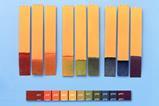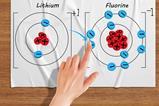Avoid making mountains out of molehills with ideas for tackling this crucial unit
The subject of the mole has a fearsome reputation among both teachers and students. I am sure there are 16 year-olds who wish that Avogadro had never discovered his gas law in 1811, leading Nobel laureate Jean Baptiste Perrin to propose the naming of Avogadro’s constant in 1909.
There are no shortcuts when it comes to teaching moles. It’s a topic that needs time and careful planning, but there are some small tweaks that can boost your teaching of this crucial unit.
The subject of the mole has a fearsome reputation among both teachers and students. I am sure there are 16 year-olds who wish that Avogadro had never discovered his gas law in 1811, leading Nobel laureate Jean Baptiste Perrin to propose the naming of Avogadro’s constant in 1909.
There are no shortcuts when it comes to teaching moles. It’s a topic that needs time and careful planning, but there are some small tweaks that can boost your teaching of this crucial unit. To help learners, display our moles poster (rsc.li/3B49vcL) in your classroom, find out the common misconceptions in this post-16 CPD article (rsc.li/3Xq5RRS) and use these tips.
1. Collaborate with colleagues
Brainstorm learning sequences with other teachers, in and between departments, to find the best way to tackle moles. Exam specifications are not a teaching order, and different cohorts of students respond differently to this calculation-heavy topic. I’ve had classes to whom I’ve taught every single mole calculation in the same block over just a few weeks and they’ve thrived on it. But I’ve also had to take a slower approach, interleaving the calculations with other topics to give learners time to consolidate knowledge before adding more.
Brainstorm learning sequences with other teachers to find the best way to tackle moles. Talk to the maths department to share ideas and techniques (rsc.li/3XFWa3i). Exam specifications are not a teaching order, and different cohorts of students respond differently to this calculation-heavy topic. I’ve had classes to whom I’ve taught every single mole calculation in the same block over just a few weeks and they’ve thrived on it. But I’ve also had to take a slower approach, interleaving the calculations with other topics to allow time for learners to consolidate knowledge before adding more.
2. Go back to basics

Use analogies but check that they’re understood before you do. The most common analogy for a mole is that it is just a specific number of particles, like a dozen is a particular number of roses, doughnuts, oysters or eggs. With supermarket deliveries and convenience shopping, there probably aren’t too many teenagers whose parents or carers send them to the shop to buy 12 eggs. If this lack of social capital is an issue in your class, then a useful starting point could be introducing non-numerical names for quantities, such as dozen, couple, grand and gross.
3. Adapt your teaching
Try combinations of formulas and statements of proportion to help learning stick. We use moles in many different calculations, with the symbol n substituted into lots of formulas. Different methods of showing the relationships work for different students. Some students prefer moles presented to them like mathematical formulas. Learning n = cv/1000 and moles = mass/relative formula mass stick well for them. Other students need the story of the mathematical relationships – well-phrased explanations such as ‘one mole of an element has a mass equivalent to its relative atomic mass’ work best for them. Try to have a few different ways of presenting the key concepts so you can give all your students the best chance of understanding this difficult topic.
Try combinations of formulas and statements of proportion to help learning stick. We use moles in many different calculations, with the symbol n substituted into lots of formulas. Different methods of showing the relationships work for different students. Some students prefer moles presented to them like mathematical formulas. Learning n = cv/1000 and moles = mass/relative formula mass stick well for them. Other students need the story of the mathematical relationships – well-phrased explanations such as ‘one mole of an element has a mass equivalent to its relative atomic mass’ work best for them. Try to have a few different ways of presenting the key concepts so you can give all your students the best chance of understanding this difficult topic.
4. Try live modelling
Sometimes students just don’t know where to start. Although my advice would always be to find a way to calculate moles, they don’t see how to take the information presented in the question and begin. Showing your thinking using a visualiser or tablet can really help students develop the reasoning skills they need to decode the question. Live modelling simple steps such as highlighting the numbers (and their units) given in the question and then deciding which of the mole calculations those numbers fit into helps students make a start on a problem. If you are new to teaching this topic it’s useful to rehearse live modelling in advance of the session. You can do this by recording a video of your teaching, or simply writing down your thought processes on a separate page as you work through a problem.
Sometimes students just don’t know where to start. Although my advice would always be to find a way to calculate moles, they don’t see how to take the information presented in the question and begin. Showing your thinking using a visualiser or tablet can really help students develop the reasoning skills they need to decode the question. Live modelling simple steps such as highlighting the numbers (and their units) given in the question and then deciding which of the mole calculations those numbers fit into helps students make a start on a problem. If you are new to teaching this topic it’s useful to rehearse live modelling in advance of the session. You can do this by recording a video of your teaching, or simply writing down your thought processes on a separate page as you work through a problem.
Remember they’re new to it
As a teacher who has understood moles for a long time it can be difficult to imagine not knowing about this core concept. Remember that it can be a very difficult concept for novices – even if students seem to be finding it easy, try not to skip over deliberate practice of each step in the learning sequence.
Teaching moles is a marathon not a sprint, and your lessons will evolve as you see how students respond. In more than 18 years of teaching, I don’t think I’ve taught this unit in the same way twice.
Kristy Turner














2 readers' comments